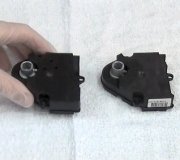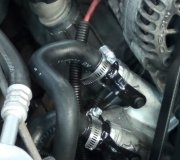Well, I've been teaching Automotive Technology for years, and I attend every class when we borrow our classroom for manufacturer-sponsored classes for dealership mechanics. I'm not going to change what we have all been teaching for years. Bare in mind too what you read in service manuals or online often doesn't agree with real life. Every week I worked at a new-car dealership we got a handful of new pages to stick in our service manuals. Those were to correct mistakes and to update them for mid-year design changes. Car owners who ordered those service manuals from the training centers don't get those update pages.
I can understand you may not be getting the results and the performance you did in the past, but you have to look at the huge volume of air you're passing through the evaporator. You can burn your hand on a lit match, but it isn't going to heat even a tiny room in your house.
One of the main purposes of air conditioning is to remove the humidity from the air. 85 degrees can be quite comfortable if the humidity is real low. To do that, you know the cold evaporator is being covered with that condensed water, and you know that water will freeze and block the air flow if the evaporator gets down to 32 degrees. All manufacturers regulate it to keep it near 40 degrees. Those are design facts that aren't open for dispute.
The hot air coming in isn't in contact with the evaporator's fins long enough to draw all of the heat out. Air does get that cold in a refrigerator but that's with air that's stagnant and not being changed constantly. Mitsubishi does indeed say duct temperature should be 37 - 40 degrees, but that's after 20 minutes, and only in the "Recirculation" mode. In that mode, cooled inside air is run through the evaporator repeatedly with only a little fresh outside air being introduced.
Your compressor is supposed to cycle off if the air leaving the evaporator gets down to 28 degrees, and it sounds like that's what's happening. Any chance that temperature sensor is mispositioned?
There are other potential causes of insufficient cooling, but if you pulled the system into a vacuum, and you said the pressure switches are working, I would have to assume you put new refrigerant in, and I have no reason to doubt you put the right amount in, so there's no point in looking in that area for a problem. You might consider a sticking blend air door that is allowing some heated air to mix with the cooled air.
From everything you've said, it sounds to me like the refrigerant circuit is working as designed and that is not the area to be looking. Can you see frost forming on either of the hoses under the hood where they pass through the firewall? Expect to see a little on the low side suction hose, but if a lot is forming, that is where the cooling is taking place instead of in the evaporator. That points to the system is over-charged. If you see a lot of frost forming on the high-side hose in one spot, that suggests there's a restriction at that point.
Also be sure the condenser fan is running. If it is not, the more common symptom is the high-pressure relief valve will blow, but before that you are likely to get good cooling while driving and natural air flow keeps the condenser cooled. We can rule out a butterfly collection in the condenser since that is new. Likewise, the receiver / drier likely isn't plugged since that is new.
You also found the high and low side pressures to be perfect. That means there's nothing to fix there. Many owners have complained about some Honda models not cooling well since they were new, and testing has shown duct temperature only gets down to the mid 60s. Honda says that is normal and was how those systems were designed. Of course they improved their systems after a few years of hearing those complaints.
What I would do at this point is first to verify water is dripping from the condensate hose after the system has been running a while. If you see that, we need to look at other possible causes like the blend air door. If you don't see water dripping, either ice has formed on the evaporator from over-cooling, or the system is low on charge, which I doubt. For over-cooling, you know the refrigerant system is working. It's working too well. That's where I'd look at the placement of the temperature sensors.
One last comment of value. You can always have a failed temperature sensor, but my frequent comment is those are the last things to suspect. Temperature sensors have just one component inside them, so failures are very rare. It's much more common to find a broken wire or corrosion on the connector terminals. Ford did have to prove me wrong by having a huge rash of coolant temperature sensor failures in the early '90s, but that was due to a manufacturing problem. It's also real uncommon to find a sensor that is out-of-specs. We don't even teach testing them for resistance since that is a waste of time and therefore the customer's money. All manufacturers provide typical specs in their service manuals, but those are only for training purposes. If you were to test a dozen temperature sensors from properly-running systems, you would find near half of them read out-of-specs, so what's the value in testing them? The exception is if a temperature sensor has three or more wires. That means it has power and ground wires to power additional internal circuitry. That circuitry certainly can fail. Mass air flow sensors with built-in intake air temperature sensors are a good example.
Wednesday, September 8th, 2021 AT 3:55 PM


